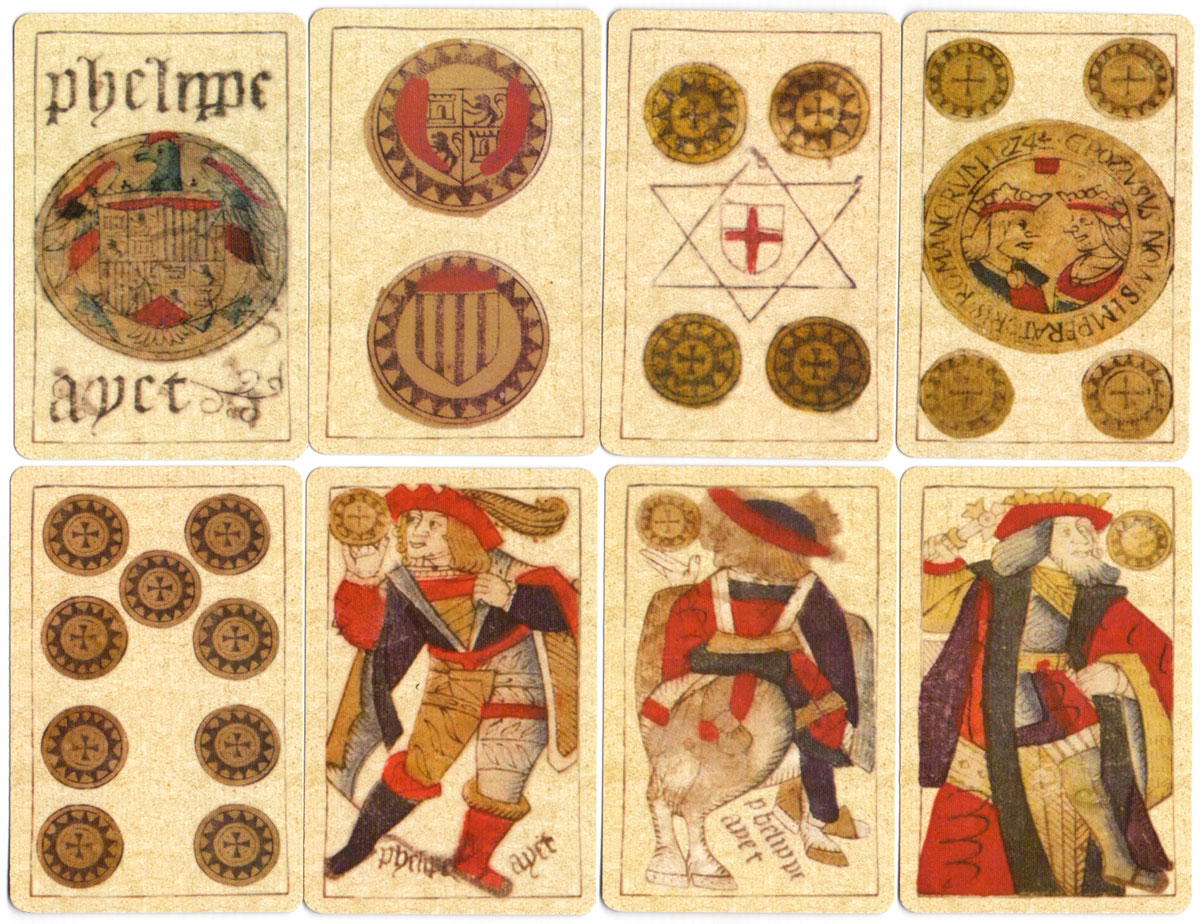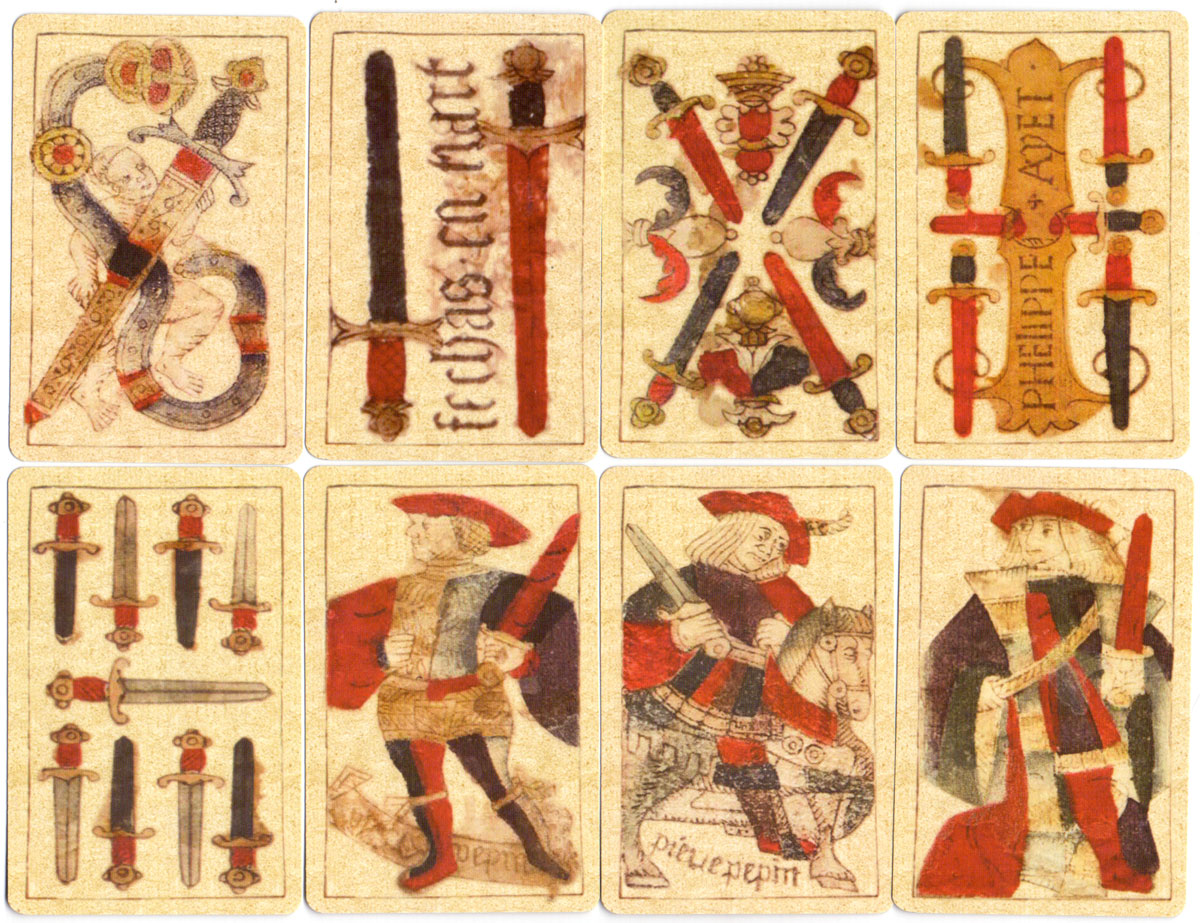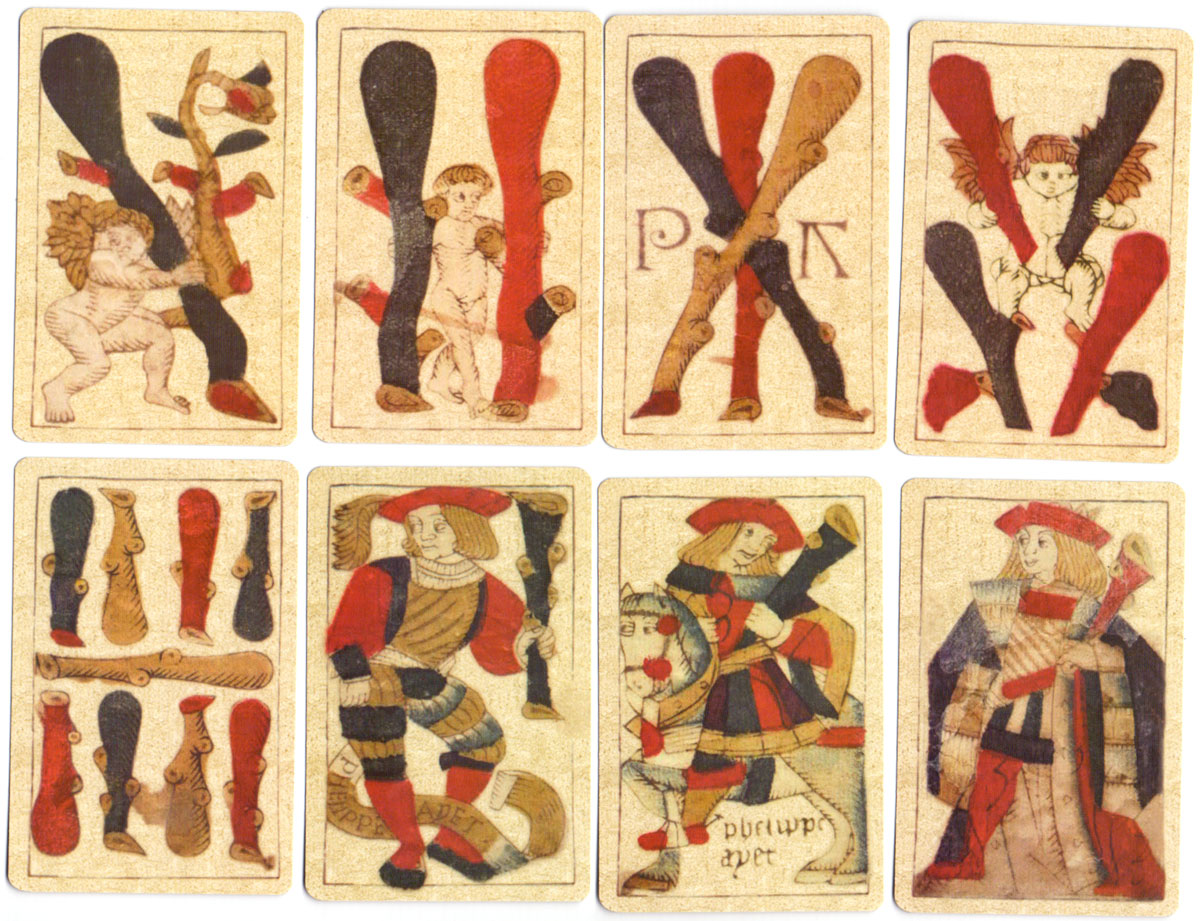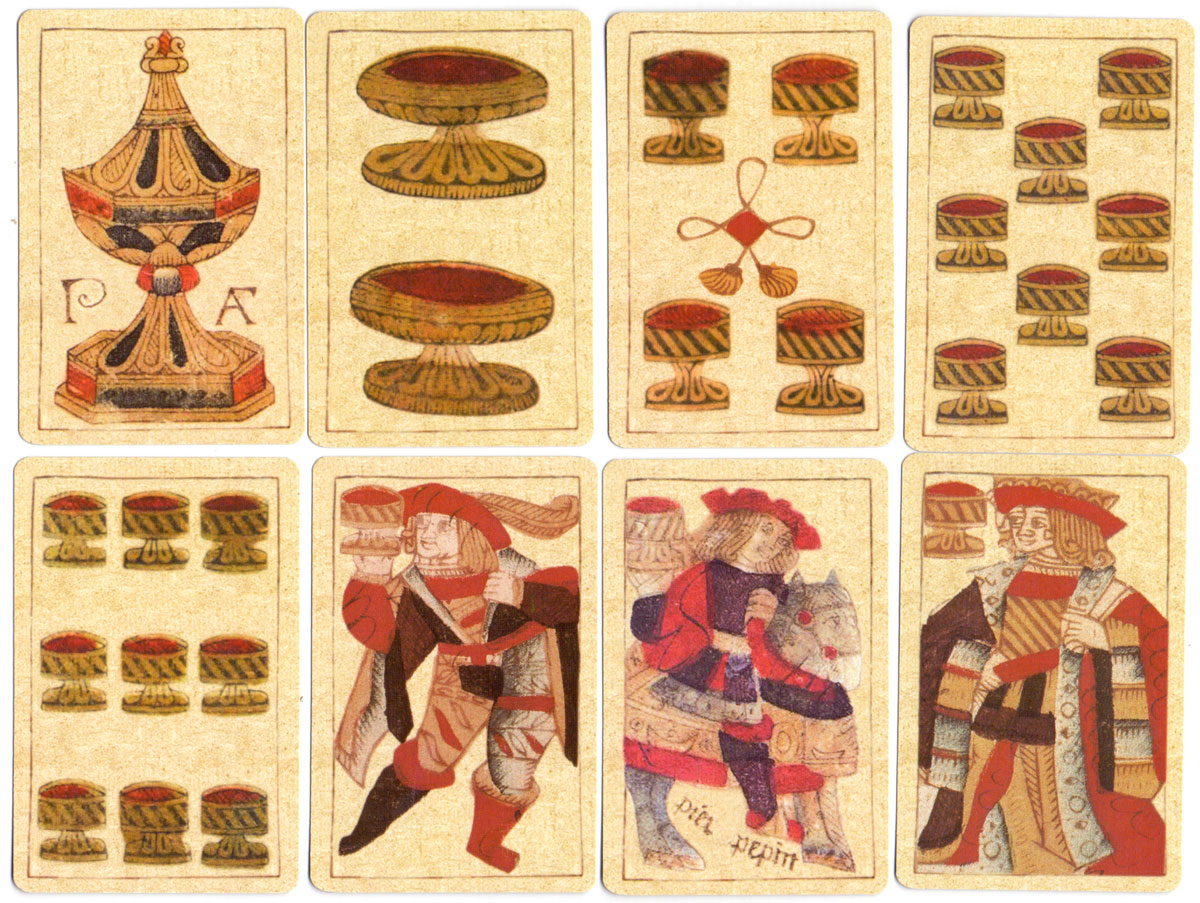Phelippe Ayet, 1574
49 assorted cards were found hidden in the lintel of a doorway, in an old building in Toledo, during demolition, and are now preserved in the the Museo de Santa Cruz de Toledo.
Facsimile of Archaic Spanish-suited playing cards.




Above: facsimile cards of archaic Spanish-suited pattern, printed from woodcuts by Phelippe Ayet and and Pierre Pepin, dated 1574. Phelippe Ayet was a card maker living in Valencia. Pierre Pepin was a French card maker who operated in Seville and who was known by Miguel Cervantes. A total of 49 assorted cards by these different makers were found hidden in the lintel of a doorway, in an old building in Toledo, during demolition, and are now preserved in the the Museo de Santa Cruz de Toledo. Size: 57 x 98 mms, reverse blank. Another similar pack has been discovered in Madrid by the same maker, who was recorded as residing in the Valencia region at that time. Cards from facsimile edition by Naipes Comas, 2002. The set includes 2 explanatory cards→
The archaic Franco-Spanish pattern was produced and used in both France and Spain and several of the court card postures have survived in other regional patterns. The king of coins brandishing an axe recurs in several former French regional patterns and survives today in the king of hearts (‘suicide king’) in modern poker packs. In the example illustrated below, the ace of coins carries the coat of arms of the Catholic Monarchs, as well as the double-headed eagle of the Habsburgs topped by the crown of the empire of Charles V.

Above: 48-card Franco-Spanish pattern deck produced by Diego del Campo, Toledo, c.1540. Diego del Campo is believed to have been a Frenchman who travelled to Spain in the mid-16th century fleeing political and religious wars in France. Along with a group of card makers, he settled in Spain, moving through cities like Logroño, Burgos, Valladolid and Segovia, before reaching Toledo, the capital of the Empire at the time. However, these playing cards are not solely attributed to Diego del Campo, as Guillermo Moreo is also credited on several cards.
References
Lopez, Nacho: Descubierta la baraja más antigua del mundo, que fue fabricada en Castilla-La Mancha en 1540 in El Digital de Albacete 16 octubre, 2023►
Martín Carrillo, Alejandro: La baraja de cartas española más antigua del mundo se hizo en Toledo y data del 1540 in cadenaser.com 21/10/2023►
Denning, Trevor: The Playing-Cards of Spain, Cygnus Arts, London, 1996 - see p.46.
Anonymous uncut sheet dated 1587
On the three of clubs (first row second from the right) is the inscription F.T° that refers to Toledo. The same letters are repeated on the card with the 4 of chalices (second row fourth from the left) and on the next card at right the three of chalices is the year 1587. The profiles of the Catholic kings (Isabel and Ferdinand) on the three of coins and the coat of arms of Castilla and Leon and Aragon (partly trimmed from bottom) form the two of coins.

Above: on the 3 of clubs and 4 of cups are the initials F.T°. (Toledo), and the date 1587 appears on the 2 of cups. The 4 of coins bears a merchant's mark, the 2 has the arms of Leon and Castile, and on the 5 is the usual coin with two heads. Woodcut, hand coloured using stencils. © The Trustees of the British Museum • Museum number 1896,0501.1346►

By Simon Wintle
Member since February 01, 1996
I am the founder of The World of Playing Cards (est. 1996), a website dedicated to the history, artistry and cultural significance of playing cards and tarot. Over the years I have researched various areas of the subject, acquired and traded collections and contributed as a committee member of the IPCS and graphics editor of The Playing-Card journal. Having lived in Chile, England, Wales, and now Spain, these experiences have shaped my work and passion for playing cards. Amongst my achievements is producing a limited-edition replica of a 17th-century English pack using woodblocks and stencils—a labour of love. Today, the World of Playing Cards is a global collaborative project, with my son Adam serving as the technical driving force behind its development. His innovative efforts have helped shape the site into the thriving hub it is today. You are warmly invited to become a contributor and share your enthusiasm.
Related Articles

Tarot de las Coscojas
Historical playing card design, tarot symbolism and an almost psychedelic medieval surrealism.

Tarot de Valverde de la Vera
A series of 24 surrealist engravings by Mexican artist Claudio Favier in which archetypal Tarot alle...

Baraja de Juan Martín Zamorano
Deck inspired by El Pendón de los Zamorano, a military pennant dating from 1501, published by Priego...

Heráldica Castanyer No. 16
Strange variant of international pattern cards for poker or bridge.

Fantasy Spanish-suited deck
Fantasy Spanish-suited deck by Bertschinger y Codina, Barcelona.

Trappola cards from Poland
Trappola cards published in Warsaw by J G Du Port during the 18th century.

Bertschinger y Codina - Cartes Françaises
French ‘Paris’ pattern made by Bertschinger y Codina, Barcelona, c.1850.

Braulio Fournier
Baraja Nº 1 produced by Braulio Fournier, Burgos, c.1868.

Pirritx eta Porrotx
Happy Families card game from the Spanish Basque Country.

Naipe Vizcaino
‘Naipe Vizcaino’ designed by Javier Urkiri and published by Industrias Gráficas Castuera and the Caj...

Baraja Turística del País Vasco
Basque poker deck of 55 cards published by Fournier with scenic views of the Basque Country.

Baraja Vasca
Spanish Basque Country deck with original drawings by María Isabel Ibañez de Sendadiano.

Baraja Cultura Española
ASESCOIN pack for 2022 designed by M.A. Corella featuring famous Spaniards and notable buildings.

Laurenzo Propagine
Spanish-suited cards made in Italy by Laurenzo Propagine.

Jeu de 7 familles Les Dynasties d’Artisans Basques
Long-standing Basque businesses represented in a traditional card game with illustrations by Odile A...

Archaic Franco-Spanish pattern
Archaic Franco-Spanish pattern by Guillaume & Jean Grossard (Bordeaux).
Most Popular
Our top articles from the past 28 days

